Influence of Rock Slide Geometry on Stability Behavior during Reservoir Impounding
Abstract
:1. Introduction
2. Materials and Methods
3. Rock Slide Characterization and Dam Reservoir-Related Mechanisms
3.1. Rock Slide Structure and Hydrogeology
3.2. Block Model
4. Impact of Rock Slide Geometry on Reservoir Impounding Behavior
4.1. Selected Case Studies
4.2. Limit-Equilibrium Analyses
5. Discussion
6. Conclusions
Supplementary Materials
Author Contributions
Funding
Data Availability Statement
Acknowledgments
Conflicts of Interest
Appendix A
References
- Riemer, W. Landslides and reservoirs. In Proceedings of the 6th International Symposium on Landslides, Christchurch, New Zealand, 10–14 February 1992; pp. 213–224. [Google Scholar]
- Moore, D.P. Rock slopes and reservoirs—Lessons learned. In Proceedings of the 13th Annual Vancouver Geotechnical Society Symposium, Slope Stability and Landslides, Vancouver, BC, Canada, 28 May 1999. [Google Scholar]
- Kalenchuk, K.S.; Hutchinson, D.J.; Diederichs, M.S. Downie Slide: Numerical simulation of groundwater fluctuations influencing the behaviour of a massive landslide. Bull. Eng. Geol. Environ. 2013, 72, 397–412. [Google Scholar] [CrossRef]
- Macfarlane, D.F. Observations and predictions of the behaviour of large, slow-moving landslides in schist, Clyde Dam reservoir, New Zealand. Eng. Geol. 2009, 109, 5–15. [Google Scholar] [CrossRef]
- Genevois, R.; Tecca, P.R. The Vajont landslide: State-of-the-art. Ital. J. Eng. Geol. Environ. 2013, 15–39. [Google Scholar] [CrossRef]
- Barla, G.; Antolini, F.; Barla, M.; Mensi, E.; Piovano, G. Monitoring of the Beauregard landslide (Aosta Valley, Italy) using advanced and conventional techniques. Eng. Geol. 2010, 116, 218–235. [Google Scholar] [CrossRef]
- Lin, P.; Lui, X.; Hu, S.; Li, P. Large deformation analysis of a high steep slope relating to the Laxiwa Reservoir, China. Rock Mech. Rock Eng. 2016, 49, 2253–2276. [Google Scholar] [CrossRef]
- Zhang, D.; Wang, G.; Yang, T.; Zhang, M.; Chen, S.; Zhang, F. Satellite remote sensing-based detection of the deformation of a reservoir bank slope in Laxiwa Hydropower Station, China. Landslides 2013, 10, 231–238. [Google Scholar] [CrossRef]
- Watson, A.D.; Psutka, J.F.; Stewart, T.W.; Moore, D.P. Investigations and Monitoring of Rock Slopes at Checkerboard Creek and Little Chief Slide. In Proceedings of the 1st Canada-U.S. Rock Mechanics Symposium, Vancouver, BC, Canada, 27–31 May 2007. [Google Scholar]
- Zangerl, C.; Strauhal, T. Investigations and monitoring of deep-seated rock slides in feasibility studies for dam reservoirs. AUC Geogr. 2020, 55, 210–217. [Google Scholar] [CrossRef]
- Zarfl, C.; Lumsdon, A.E.; Berlekamp, J.; Tydecks, L.; Tockner, K. A global boom in hydropower dam construction. Aquat. Sci. 2015, 77, 161–170. [Google Scholar] [CrossRef]
- Alonso, E.E.; Pinyol, N.M. Landslides in reservoirs and dam operations. In Proceedings of the 2nd International Congress on Dam Maintenance and Rehabilitation, Zaragoza, Spain, 23–25 November 2010; CRC Press: Boca Raton, FL, USA, 2011; pp. 3–28. [Google Scholar]
- Miller, S.M.; Barla, G.; Piovano, G.; Barla, M. Geotechnical and temporal risk assessment of a large slope deformation. In Proceedings of the 42nd U.S. Rock Mechanics Symposium (USRMS), San Francisco, CA, USA, 29 June–1 July 2008. Paper No. ARMA-08-032. [Google Scholar]
- Alonso, E.E.; Pinyol, N.M. Criteria for rapid sliding I. A review of Vaiont case. Eng. Geol. 2010, 114, 198–210. [Google Scholar] [CrossRef]
- Macciotta, R.; Martin, C.D.; Morgenstern, N.R.; Cruden, D.M. Development and application of a quantitative risk assessment to a very slow moving rock slope and potential sudden acceleration. Landslides 2016, 13, 765–785. [Google Scholar] [CrossRef]
- Eaton, J.W.; Bateman, D.; Hauberg, S.; Wehbring, R. GNU Octave Version 8.4.0 Manual: A High-Level Interactive Language for Numerical Computations. 2023. Available online: https://www.gnu.org/software/octave/doc/v8.4.0/ (accessed on 1 December 2023).
- AutoCAD, Version 2016. 2016. Available online: https://www.autodesk.com/ (accessed on 1 May 2016).
- Rocscience Slide2, Version 7—2D Limit Equilibrium Slope Stability Analysis; Rocscience Inc.: Toronto, ON, Canada, 2018; Available online: www.rocscience.com (accessed on 15 December 2018).
- Abramson, L.W.; Lee, T.S.; Sharma, S.; Boyce, G.M. Slope Stability and Stabilization Methods; John Wiley & Sons: Hoboken, NJ, USA, 2001. [Google Scholar]
- Noverraz, F. Sagging or deep-seated creep: Fiction or reality? In Proceedings of the 7th International Symposium on Landslides, Trondheim, Norway, 17–21 June 1996; Balkema: Rotterdam, The Netherlands, 1996; pp. 821–828. [Google Scholar]
- Strauhal, T.; Zangerl, C.; Fellin, W.; Holzmann, M.; Engl, D.A.; Brandner, R.; Tessadri, R. Structure, mineralogy and geomechanical properties of shear zones of deep-seated rockslides in metamorphic rocks (Tyrol, Austria). Rock Mech. Rock Eng. 2017, 50, 419–438. [Google Scholar] [CrossRef]
- Agliardi, F.; Crosta, G.; Zanchi, A. Structural constraints on deep-seated slope deformation kinematics. Eng. Geol. 2001, 59, 83–102. [Google Scholar] [CrossRef]
- Crosta, G.B.; Di Prisco, C.; Frattini, P.; Frigerio, G.; Castellanza, R.; Agliardi, F. Chasing a complete understanding of the triggering mechanisms of a large rapidly evolving rockslide. Landslides 2014, 11, 747–764. [Google Scholar] [CrossRef]
- Bonzanigo, L.; Eberhardt, E.; Loew, S. Long-term investigation of a deep-seated creeping landslide in crystalline rock, Part I. Geological and hydromechanical factors controlling the Campo Vallemaggia landslide. Can. Geotech. J. 2007, 44, 1157–1180. [Google Scholar] [CrossRef]
- Zangerl, C.; Chwatal, W.; Kirschner, H. Formation processes, geomechanical characterisation and buttressing effects at the toe of deep-seated rock slides in foliated metamorphic rock. Geomorphology 2015, 243, 51–64. [Google Scholar] [CrossRef]
- Loew, S.; Strauhal, T. Pore Pressure Distributions in Brittle Translational Rockslides. Ital. J. Eng. Geol. Environ. 2013, 13, 181–191. [Google Scholar]
- Strauhal, T.; Loew, S.; Holzmann, M.; Zangerl, C. Detailed hydrogeological analysis of a deep-seated rockslide at the Gepatsch reservoir (Klasgarten, Austria). Hydrogeol. J. 2016, 24, 349–371. [Google Scholar] [CrossRef]
- Imrie, A.S.; Moore, D.P.; Enegren, E.G. Performance and maintenance of the drainage system at Downie Slide. In Proceedings of the 6th International Symposium on Landslides, Christchurch, New Zealand, 10–14 February 1992; pp. 751–765. [Google Scholar]
- Eberhardt, E.; Bonzanigo, L.; Loew, S. Long-term investigation of a deep-seated creeping landslide in crystalline rock. Part II. Mitigation measures and numerical modelling of deep drainage at Campo Vallemaggia. Can. Geotech. J. 2007, 44, 1181–1199. [Google Scholar] [CrossRef]
- Paronuzzi, P.; Rigo, E.; Bolla, A. Influence of filling-drawdown cycles of the Vajont reservoir on Mt. Toc slope stability. Geomorphology 2013, 191, 75–93. [Google Scholar] [CrossRef]
- Zangerl, C.; Schneeberger, A.; Steiner, G.; Mergili, M. GIS-based topographic reconstruction and geomechanical modelling of the Köfels Rock Slide. Nat. Hazards Earth Syst. Sci. Discuss. 2020, 1–31. [Google Scholar] [CrossRef]
- Nicolussi, K.; Spötl, C.; Thurner, A.; Reimer, P.J. Precise radiocarbon dating of the giant Köfels landslide (Eastern Alps, Austria). Geomorphology 2015, 243, 87–91. [Google Scholar] [CrossRef]
- Donati, D.; Westin, A.M.; Stead, D.; Clague, J.J.; Stewart, T.W.; Lawrence, M.S.; Marsh, J. A reinterpretation of the Downie Slide (British Columbia, Canada) based on slope damage characterization and subsurface data interpretation. Landslides 2021, 18, 1561–1583. [Google Scholar] [CrossRef]
- Barla, G. Long term behaviour of the Beauregard dam (Italy) and its interaction with a deep-seated gravitational slope deformation. In Mitteilungen für Ingenieurgeologie und Geomechanik, Proceedings of the 5th Colloquium of Rock Mechanics—Theory and Practice, Vienna, Austria, 26–27 November 2009; TU Wien: Vienna, Austria, 2010; Volume 9, pp. 111–125. [Google Scholar]
- Hendron, A.J.; Patton, F.D. The Vaiont Slide. A Geotechnical Analysis Based on New Geologic Observations of the Failure Surface, Volume 1: Main Text; US Army Corps of Engineers: Washington, DC, USA, 1985. [Google Scholar]
- Dykes, A.P.; Bromhead, E.N. New, simplified and improved interpretation of the Vaiont landslide mechanics. Landslides 2018, 15, 2001–2015. [Google Scholar] [CrossRef]
- Mansour, M.F.; Martin, C.D.; Morgenstern, N.R. Movement behaviour of the little chief slide. Can. Geotech. J. 2011, 48, 655–670. [Google Scholar] [CrossRef]
- Hungr, O.; Leroueil, S.; Picarelli, L. The Varnes classification of landslide types, an update. Landslides 2014, 11, 167–194. [Google Scholar] [CrossRef]
- ICOLD. Reservoir Landslides-Guidelines for Investigation and Management; Paris Bulletin 124; International Commission on Large Dams: Paris, France, 2002. [Google Scholar]
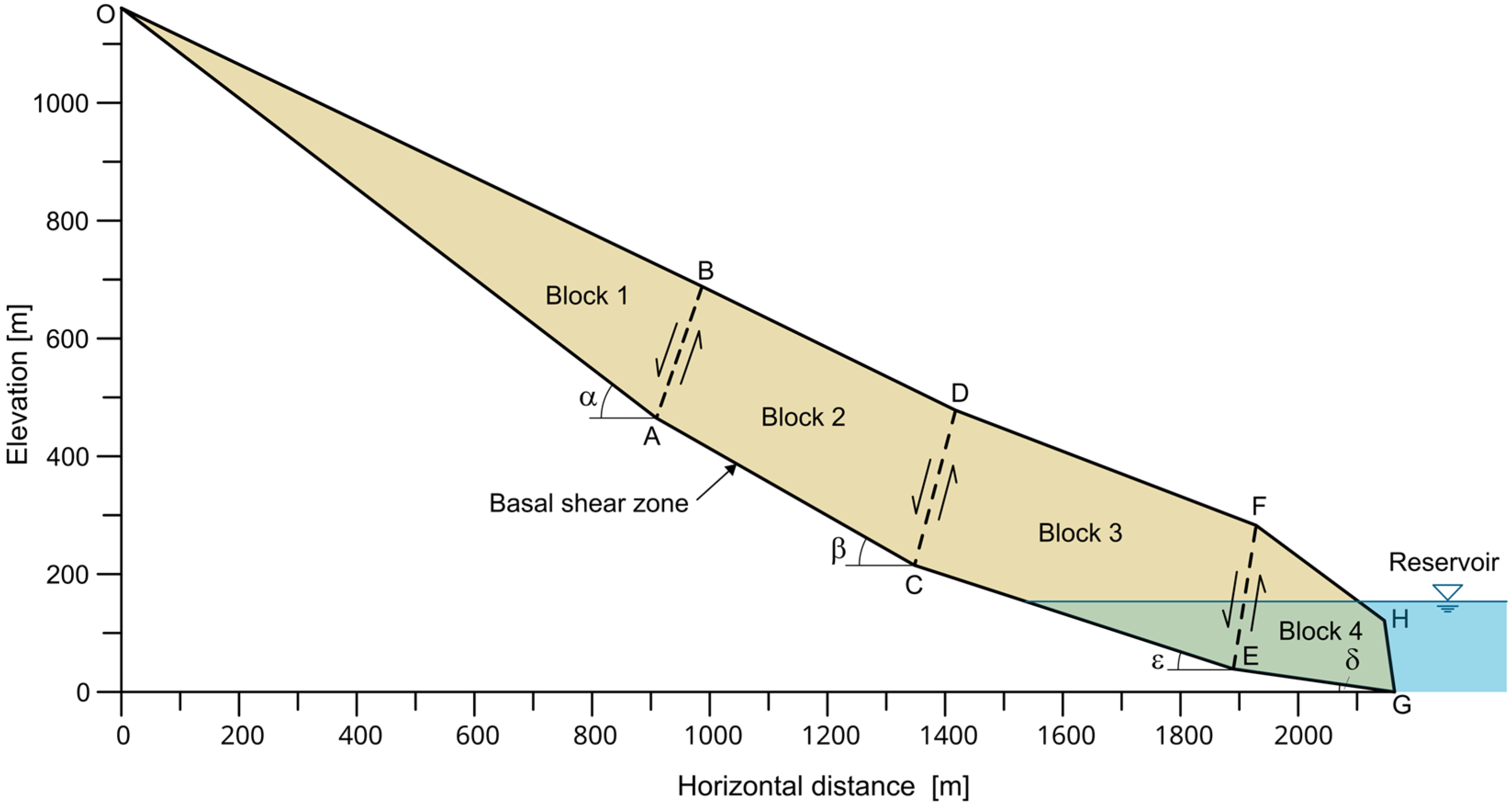
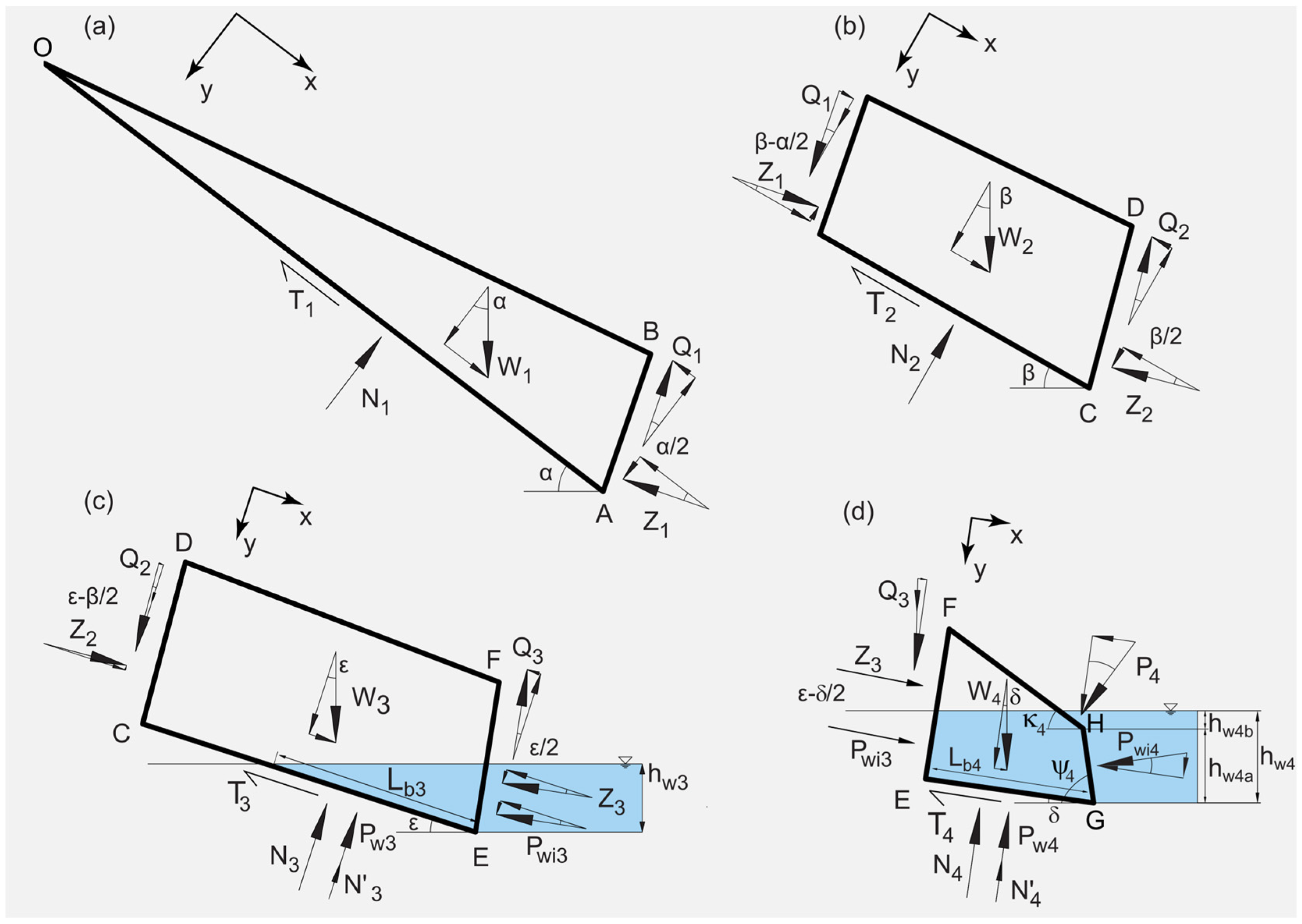

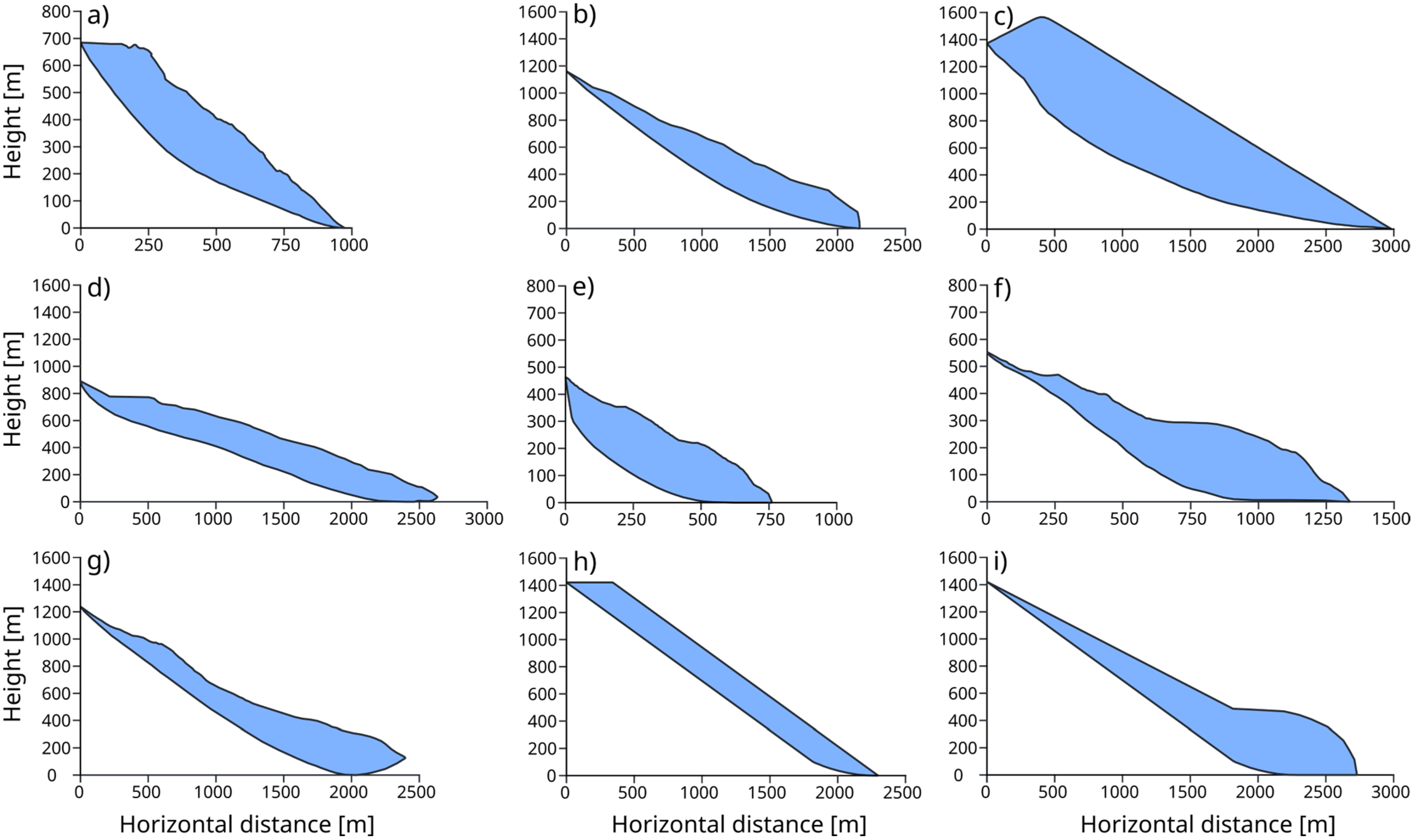
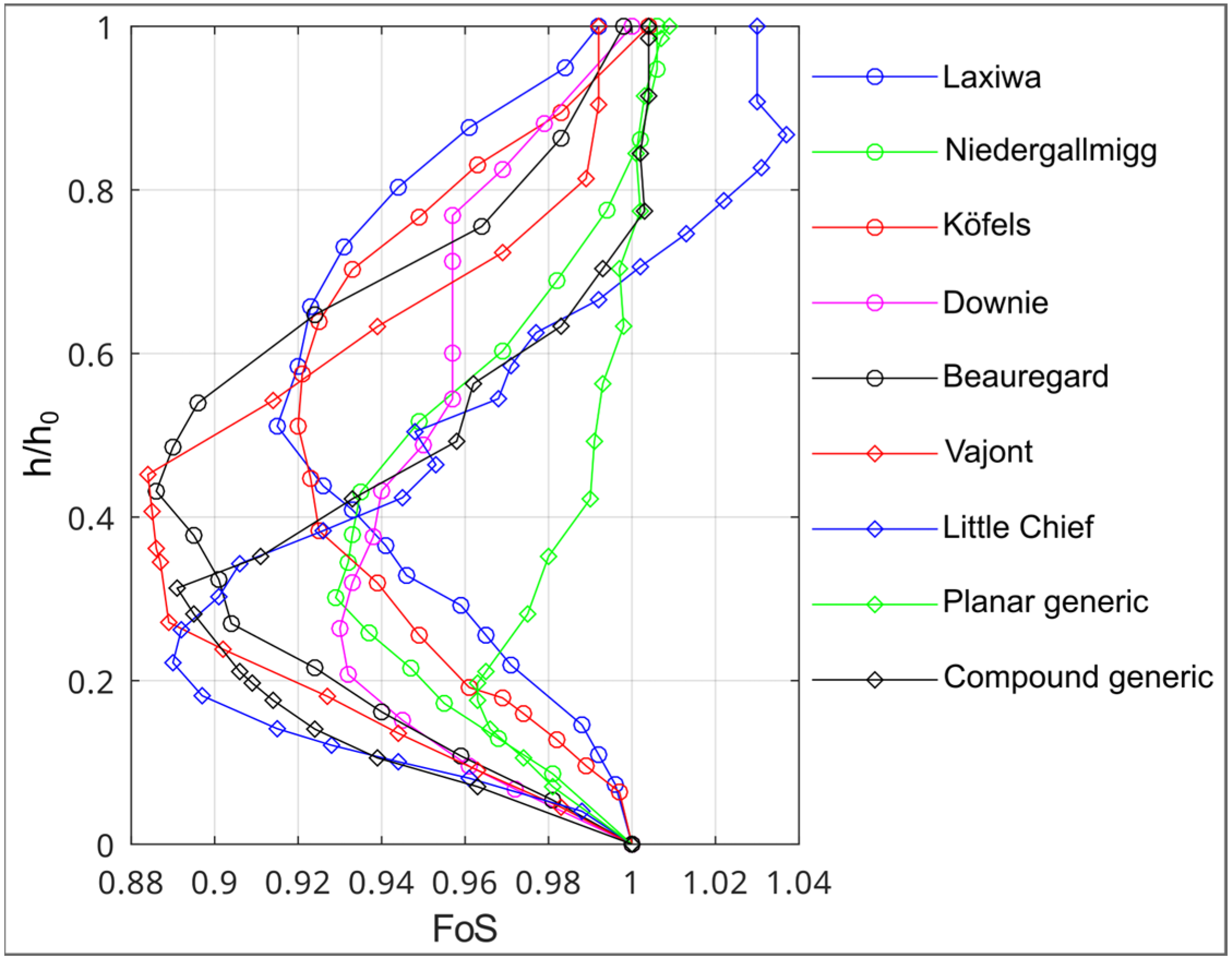
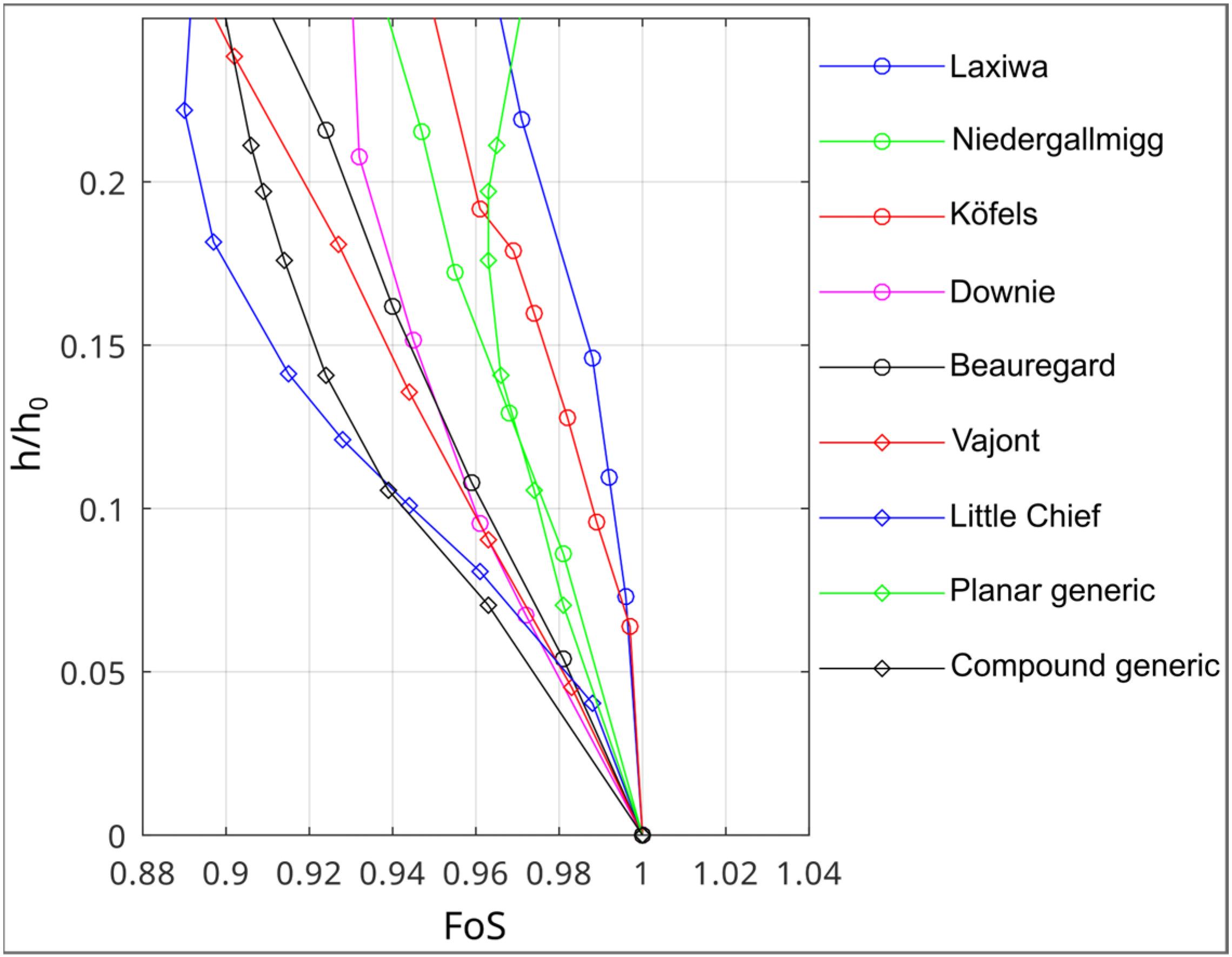
| Point | Horizontal Coordinate [m] | Vertical Coordinate [m] |
|---|---|---|
| O | 0.0 | 1161.0 |
| A | 909.4 | 464.8 |
| B | 987.5 | 688.0 |
| C | 1348.1 | 215.0 |
| D | 1417.8 | 478.1 |
| E | 1889.9 | 39.1 |
| F | 1928.5 | 282.8 |
| G | 2163.7 | 0.0 |
| H | 2146.5 | 121.0 |
| Block No. | Block Area [m2] | Shear Zone Dip [°] | Shear Zone Length [m] | Contact Plane [m] |
|---|---|---|---|---|
| Block 1 | 128,676 | α = 37.4 | OA = 1145.3 | AB = 236.5 |
| Block 2 | 122,635 | β = 29.7 | AC = 504.8 | CD = 272.2 |
| Block 3 | 143,402 | ε = 18.0 | CE = 569.6 | EF = 246.7 |
| Block 4 | 45,915 | δ = 8.1 | EF = 276.6 | - |
| Rock Slide | Vertical Height (h0) [m] | Friction Angle for FoS = 1 [°] | ΔFoS by 10% Impounding | ΔFoS by 20% Impounding |
|---|---|---|---|---|
| Laxiwa Slide | 684.7 | 32.5 | 0.007 | 0.025 |
| Niedergallmigg Slide | 1161.0 | 24.3 | 0.023 | 0.050 |
| Köfels Slide | 1565.2 | 24.4 | 0.012 | 0.041 |
| Downie Slide | 891.0 | 16.6 | 0.040 | 0.066 |
| Beauregard Slide | 463.4 | 21.4 | 0.038 | 0.071 |
| Vajont Slide | 553.0 | 16.1 | 0.041 | 0.081 |
| Little Chief Slide | 1239.2 | 18.4 | 0.056 | 0.106 |
| Planar Slide | 1421.0 | 32.5 | 0.025 | 0.037 |
| Compound Slide | 1421.0 | 19.4 | 0.058 | 0.092 |
Disclaimer/Publisher’s Note: The statements, opinions and data contained in all publications are solely those of the individual author(s) and contributor(s) and not of MDPI and/or the editor(s). MDPI and/or the editor(s) disclaim responsibility for any injury to people or property resulting from any ideas, methods, instructions or products referred to in the content. |
© 2024 by the authors. Licensee MDPI, Basel, Switzerland. This article is an open access article distributed under the terms and conditions of the Creative Commons Attribution (CC BY) license (https://creativecommons.org/licenses/by/4.0/).
Share and Cite
Zangerl, C.; Lechner, H.; Strauss, A. Influence of Rock Slide Geometry on Stability Behavior during Reservoir Impounding. Appl. Sci. 2024, 14, 4631. https://doi.org/10.3390/app14114631
Zangerl C, Lechner H, Strauss A. Influence of Rock Slide Geometry on Stability Behavior during Reservoir Impounding. Applied Sciences. 2024; 14(11):4631. https://doi.org/10.3390/app14114631
Chicago/Turabian StyleZangerl, Christian, Heidrun Lechner, and Alfred Strauss. 2024. "Influence of Rock Slide Geometry on Stability Behavior during Reservoir Impounding" Applied Sciences 14, no. 11: 4631. https://doi.org/10.3390/app14114631







